March-April 2006
Faith Of Our Generation
By Ray Brady and Rory Thynne
We represented the parish of Castleknock and traveled with representatives of other parishes in the Dublin Diocese with Catholic Youth Care.CYC organizes youth activities, from day retreats to pre-marriage courses.
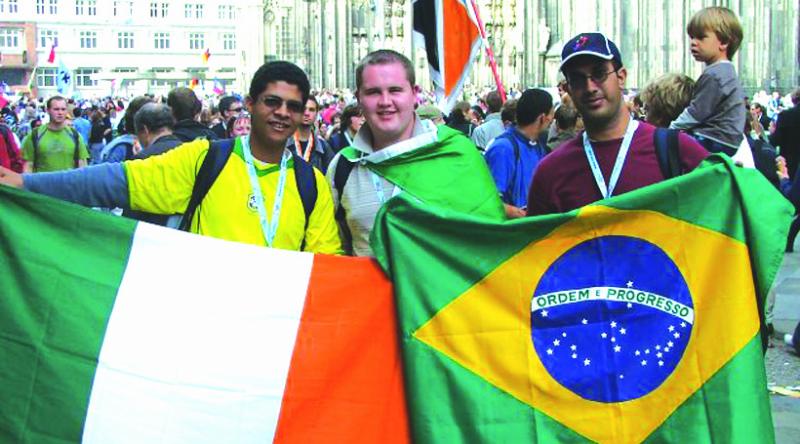
With 450 other pilgrims from the Dublin Diocese, we traveled by coach and ferry across Britain, Franceand Belgium to reach Cologne. We stopped along the way in Maredsous Monastery in Belgium for Mass celebrated by Archbishop Diarmuid Martin of Dublin, Cardinal Desmond Connell, Archbishop Emeritus, and Auxiliary Bishop Raymond Field. We then traveled on to Cologne where the parishioners and volunteers of Sankt Niklaus (St Nicholas) in Sulz, a suburb of the city, welcomed us warmly on Monday evening and brought us to our accommodation. They also hosted groups from Poland and Ghana. Some stayed with families and others in the schools and halls of the parish.
Our typical day began with morning prayers and Mass, which our priests who celebrated in a way that engaged us, with people from the many different countries staying in our host parish. They told us a lot about faith and scripture. The music of the different countries and the liturgies were beautiful, wonderful celebrations.
On Wednesday and Friday, we attended two interesting catechetical sessions in the parish church, one led by Archbishop Diarmuid Martin, the other by Cardinal Roger Mahony of Los Angeles, USA.
After Mass on Tuesday morning we visited the Dom, the impressive cathedral of Cologne. This remarkable structure houses the relics of the Magi, the Three Wise Men. The theme of our youth pilgrimage was ‘We have come to worship him,’ as they did at the birth of Christ.
Pope Benedict’s arrival in Cologne on Thursday afternoon was a very moving experience for the many thousands of young pilgrims lining the banks of the Rhine to see him for the first time. The atmosphere in the city was amazing as we followed His Holiness to the cathedral, where he prayed and then addressed us.
We spent most evenings back in our host parish where we had evening prayers and discussion followed by céilís and other activities. (Editor’s note: ‘céilí’ is a Gaelic word similar to ‘pagtitipon,’ but now usually meaning a session of Irish or Scottish dancing).
The highlight of the pilgrimage was the visit to Marienfeld, which hosted an evening vigil and a papal Mass the following morning. The vigil was a very special event, an experience I will never forget. The ceremony I thought was very respectful but there was also a lot of excitement which the weather could not dampen. When the vigil was over, some of us walked through the crowds during the night, meeting people from all five continents. There were people as far as the eye could see, something truly incredible for young people who did not have the chance to welcome the late Pope John Paul to Ireland in 1979. It made me realize that there are many, many young people all over the world who believe in God and for whom faith is very important.
The Pope made two main points in his first talk. First, he said the World Youth Day theme, 'We have come to worship him', underlined the need to understand ‘life as a pilgrimage, guided by a star, in search of the Lord.’ He said that, like the Wise Men, ‘all believers, and young people in particular, have been called to set out on the journey of life in search of truth, justice and love. The ultimate goal of that journey can only be found through an encounter with Christ, an encounter which cannot take place without faith.’
Before Benedict XVI left for Rome, he said that he hoped to communicate to young people the joy of being a Christian and let them know that the faith is more than a set of rules. He said a new wave of belief amongst young people would be a good antidote to the 'fatigue' and loss of faith across Europe in recent years. He reflected on how the Eucharist inspires Christians to evangelization. ‘Anyone who has discovered Christ must lead others to him,’ he said. ‘A great joy cannot be kept to oneself. It has to be passed on.’
At the conclusion of the Mass, the Pope renewed his challenge to the young pilgrims to bring the message of the Gospel back to their own lands. He urged them to share their faith with their neighbors, ‘especially those in difficulty,’ and to be ‘sowers of peace and brotherhood.’
To finish, we thanked the parishioners of Sankt Niklaus for their support and encouraged the young people of the parish to look forward to World Youth Day XXI in Sydney, Australia, in 2008 and to be more active in the parish.
Father Joeker

By Fr Joseph Panabang SVD
MALARIA CHILLS
At the height of my malaria, I was chilled and shaking violently. Mr Charles Kudawe, our cook, spread two more blankets over me and held me tightly to stop me from shaking. I mumbled, ‘Charles, what are you doing to me?!’ He must have thought he could stop malaria this way.
TRUST WALK
One of our activities in our Biblical Course in Nemi, Rome, was a ‘Trust Walk’ – but not the usual one. We were in pairs – as usual – but this time it was the blindfolded person leading the other. Almost everybody in the group found the activity easy except me. Do you know why? The one I was directing was our Director!
ARROW RACE
I needed to type something. I asked the rector of our house in Nemi where the typewriter was. ‘You can find it in the museum,’ he teased. So I was forced to use the computer. When Fr Vincent Wun SVD from Indonesia saw me, he asked, ‘What are you doing?’ ‘I’m trying to catch that arrow on the screen. It keeps running around!’ Talk about techno-stress!
A WARNING
Fr Joseph Banamtuan SVD from Indonesia shared in our group, ‘My mother died when I was young. Then my aunt took care of me. She too died. So, my uncle took care of me. But again he died . . .’ Turning to our rector who was seated next to me, I warned him, ‘Ittoop, you are now taking care of him. Beware!’
Festival Of Peoples
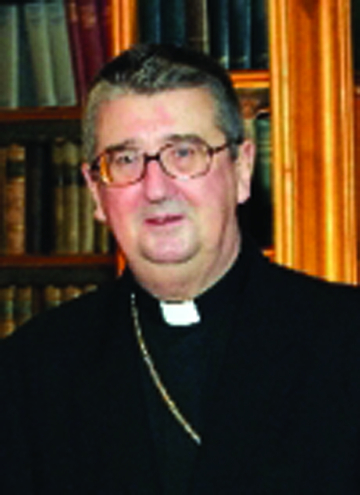 Homily of Archbishop Diarmuid Martin of Dublin, Primate of Ireland
Homily of Archbishop Diarmuid Martin of Dublin, Primate of Ireland
Archbishop Martin was speaking at a special Mass on 5 January, the Eve of the Epiphany, in Dublin’s Pro-Cathedral. The congregation included Filipinos, Poles, Nigerians, Romanians, Indians, Latvians and Brazilians, some wearing traditional dress. Readings and prayers were in different languages and there was a multi-cultural choir for the occasion. Archbishop Martin hopes that next year individual parishes will have a similar celebration. Because of emigration,Ireland’s population in 1980 was about half what it had been in 1845. But since 2000 huge numbers have been migrating into the country. The Church in the Philippines observes the First Sunday of Lent as Migrants’ Sunday.

Filipinos carrying the flag of the Philippines
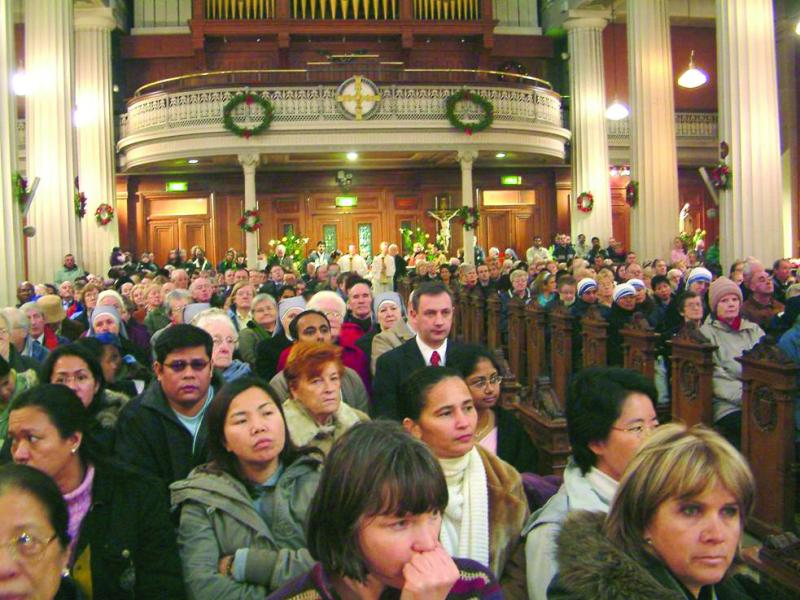
Part of the congregation at Dublin's Pro- Cathedral
We have come to a new phase in our celebration of the Mystery of Christmas, to the eve of the Feast of the Epiphany, the Feast of the revelation of Jesus to all peoples.
The Feast of the Epiphany is a popular one in many senses. I remember with affection, at home as a child, how those curious figures of the three wise men were kept waiting, as it were, for twelve days on the fringes of our crib before they were finally introduced on this day to the newly born Jesus, bringing with them their gifts. In some cultures it is on the Feast of the wise men that children receive their gifts and homes are blessed.
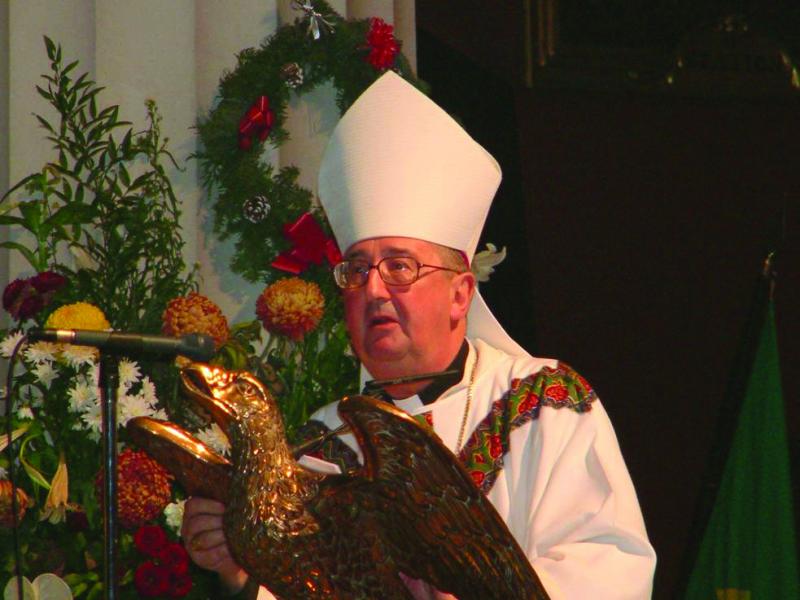
Archbishop Martin preaching
One could talk a great deal about who exactly these wise men were. We know very little beyond the traditions of different places around the world. The essential meaning of the Feast is linked to the fact that these three wise men came from afar and that, whoever they were, they represent the wider human family to which Jesus is revealed. They represent ‘all nations’; they represent the future generations of people of all races to whom the message of salvation is made known in Jesus.
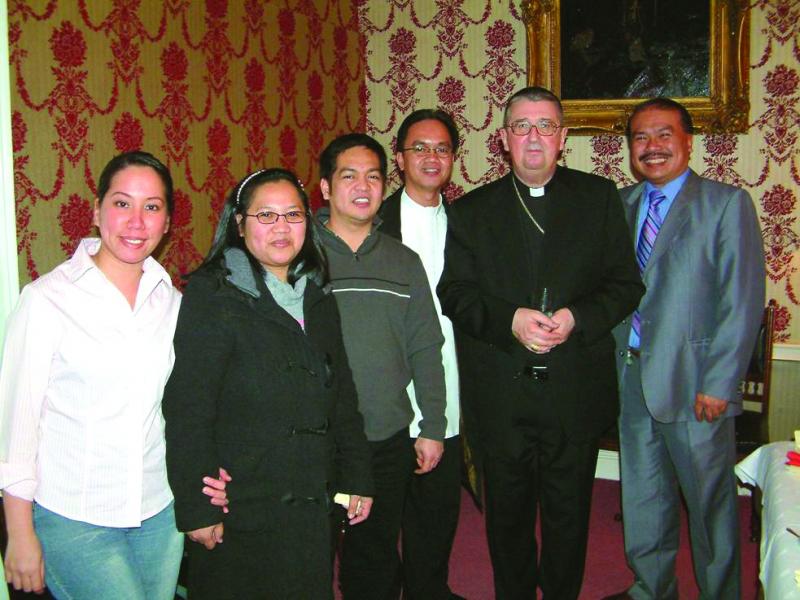
Archbishop Martin with some Filipinos after Mass
Jesus came into the world to reveal the loving-kindness of our God, whose light appeared as an invitation to all. The wise men that come to Bethlehem come from afar, from different cultural backgrounds. They represent the fact that the salvation brought by Jesus embraces all as equal members of God’s family; they are witness to the fact that the salvation which appears in Jesus is a salvation meant for all peoples; they represent the fact that Jesus embraces each one of us with the same love and that we as believers of Jesus therefore must treat each human person we encounter as a brother or a sister.
All peoples belong to the Lord and the salvation that appears in Jesus goes beyond any border of culture or ethnic or religious background. From the moment of his birth, Jesus’ message is that the people of all nations and races would come to worship at the Holy Temple which is Christ’s body.
This evening we want to celebrate that mystery in a new way for Dublin, in a changed Dublin where we recognize that our society is changing and the changing nature of what being Irish will mean in the future. Coming together we embrace all those who have come here following a star of hope for a brighter future for themselves and their families and who now enrich our lives and culture with newness and difference. We celebrate their contribution to our nation.
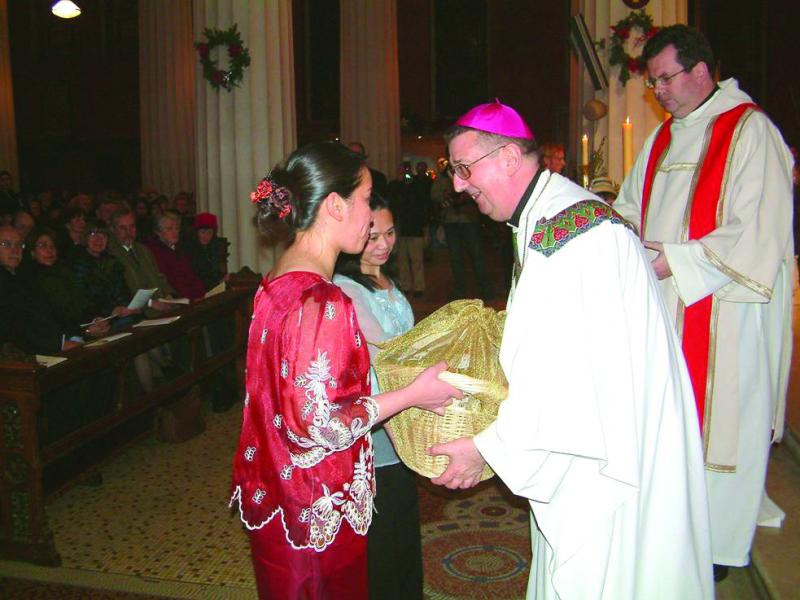
Archbishop Martin receiving gifts from the Filipinos
We celebrate the contribution of our new neighbors and friends to our economy, to our society and culture. Immigration is a phenomenon which is here with us to stay. Immigrants make a vital contribution to the growth of our economy. Without them our economy and many of our essential services, especially in healthcare, would not be able to function. Immigrants are not just units of economic policy; they are people, men and women, with families, with needs, with responsibilities, but also with talents and creativity, as well as their own culture and traditions.
Migration, the movement of people, has always been part of human history. It will inevitably be a natural dimension of a globalized world. In difficult times the Irish traveled to every corner of the globe in the harsh search for work and economic survival for themselves and their families. Thank God such harsh emigration from Ireland is a thing of the past. But in the future emigration will still be a part of the Irish experience, as our people go abroad for shorter and longer periods, bringing with them their talents and sharing the experience of our changed society and economic growth with others. A large number of our young people will spend some period of their life working abroad in some way or other.
If migration is managed in an enlightened way it can bring not just economic benefits and a form of technological interchange with other nations, but it can help us to learn about and witness to the mystery of the unity of the human family with all its rich cultural diversity.
The life of migrants however has never been an easy one. Migrants are by the nature of things fragile and vulnerable. Much has been done in Ireland to ensure that immigrants are not subjected to economic exploitation or other unfair disadvantage. The norms that are in place should be pursued vigorously. Abuses should be vigorously prosecuted. Short-term advantage should not be the supreme norm in economic activity. Lower labor costs are indeed a significant factor in giving vitality to an economy, but it is people themselves who are the driving force of a modern, knowledge-based economy and it is above all in enhancing human capacity and fostering partnership that we really enhance sustainable economic growth.
Many of those who have come to our shores live with a certain precariousness about their position. I for one support the suggestion of my Church of Ireland colleague and friend, Archbishop John Neil, that people who have lived peacefully and have made a decent life for themselves and their children in Ireland for a five-year period should now have the opportunity to have their status here regularized. Similar measures have been taken in many European Union states over the years. It would be a recognition of the dignity of those who have established roots in our society and who are contributing to the communities in which they live.
However, in the long term the real solution is not to be found in just regularizing situations of the past, but through the elaboration of an open, transparent, modern and enlightened national migration policy. Such a policy should not be reactive or somehow suspicious of people but should from the beginning be welcoming and integrating in the best sense of the word. We should continue to value the contribution of those who will come here to work. Peoples’ dignity is enhanced by the contribution that their work brings to others; but a person’s dignity does not somehow evaporate when he or she loses a particular job. Norms should respect the primacy of the person.
Just as important, we should remember that a migration policy is not only about legislative frameworks or what happens at our borders. The changes in the demographics of Irish society in recent years have been quite unprecedented. It would be foolish to think that the integration of a large number of migrants will be a simple process which will develop by itself. A climate of welcome will require social ownership of the entire process and signs of tension or rejection should be tackled as soon as they appear.
The education system as a whole is playing a vital role in this process of integration. I am aware from my own experience, that the Catholic school system in the Archdiocese of Dublin is doing great work in quietly fostering the fruitful introduction of the children of immigrants into society, as well as the introduction of all Irish children to the new intercultural reality in which they will grow up. These schools need additional support to carry out this work effectively, in some cases urgently. Schools with a large ethnic mix require special support so that each child, and the members of each ethnic group can be assisted to realize their educational potential fully and that no group is left behind or marginalized.
We need to encourage cultural diversity but also to avoid the creation, or simply the emergence in our society, of ghettoes of ethnic groups who are disadvantaged and frustrated. Experience in other countries has shown how such situations can be exploited in a manner which brings benefit to no one.
This evening’s festive Mass is a sign of the efforts of the Roman Catholic Church in Dublin to treasure and celebrate the richness of our new ethnic mixture in Ireland. The Catholic Church here in Dublin welcomes all you, wherever your trace your origins, for whatever length of time you will be here in Dublin, as full members of this local Church. Each one of us is a child of the same God. Each of us is created in God’s image. Each of us is created in God’s image. We are all brothers and sisters, we all need each other, we all can support and strengthen each other.
The Feast of the Epiphany is a special moment in the Christian calendar which stresses the openness of the mission of Jesus towards all. It stresses that no one group, whether based on class or ethnic origin or cultural affinity can claim monopoly of the goods of God’s creation or privilege in social life. The gifts of creation are for the good of all.
I would hope that each of us can go away from this celebration rejoicing in our individuality and difference. Let me recall the beautiful words of Pope Benedict XVI at his inaugural Mass: ‘Each of us is the result of a thought of God. Each of us is willed, each of us is loved, each of us is necessary.’ May that be the spirit which inspires our interaction with each other this evening and in the Ireland of the future.
Filipina Mother Gives Life For Her Child
By Father Seán Coyle
Bernadette Mimura, known as ‘Milai,’ a Filipina living in Ingleby Barwick in the north of England, was faced with a stark choice last year. Aged 37, she discovered she had breast cancer. At the time she was one month pregnant. The doctors told her that they could cure her – but that the drugs they wanted to use would be very strong and affect the baby.
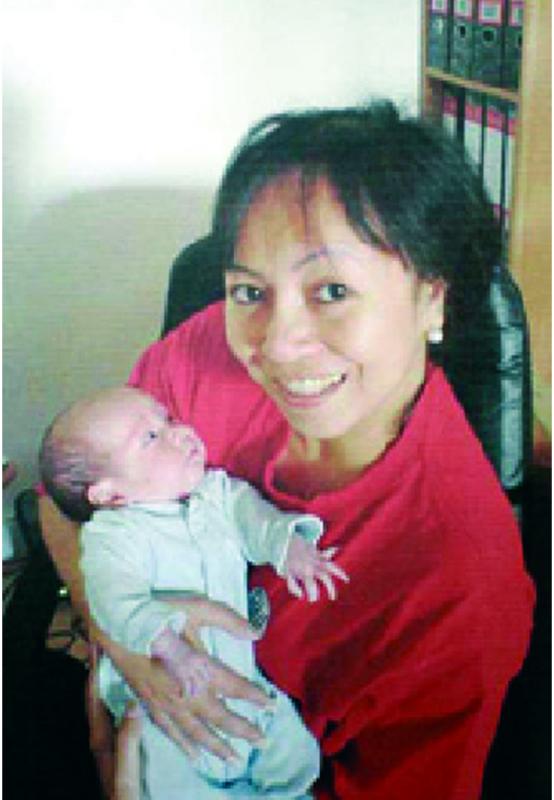
Milai chose not to take the treatment so that she could save her child. The doctors were able to give her a low dosage of chemotherapy to suppress the cancer while she was pregnant. However, when her calcium levels shot up they had to induce labor. Though his birth was two months premature, Nathan came into the world a healthy child.
This courageous young woman had the joy of seeing her son baptized by Father Alan Sheridan , her parish priest. Shortly after, she had to go into a hospice, where she died. The parishioners of Ingleby Barwick were deeply moved by the witness of Milai and wanted her remains to be buried in the Philippines and to help her three children by her Japanese husband who had divorced here, Nanam, 11, Mika, seven and five-year-old Miko.
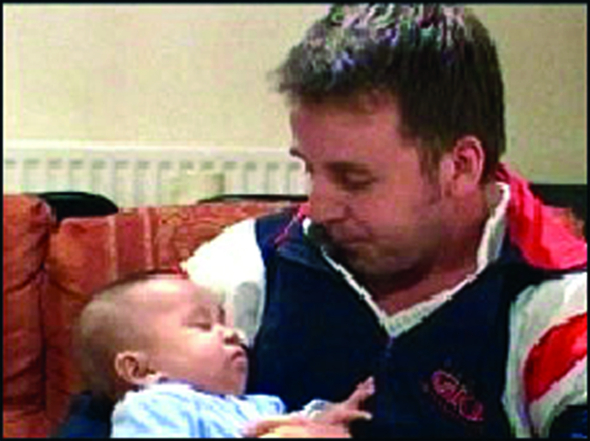
‘We began the appeal as a parish because we felt it helped us to develop our part in a universal Church and helped us to look beyond our own little corner,’ Father Sheridan wrote me in December. ‘However, one of my parishioners is a reporter for a local paper and the story then hit the front page of the local press and TV and was picked up nationally and internationally. The good news is that the publicity has helped us almost to reach our target and the Philippine Government has contributed a grant as well. Therefore Milai's body will return to the Philippines on Friday (16 December) after a funeral service here.’
The appeal target was £3,700 (approximately P370,000). Canon Sheridan added, ‘The story has touched many people locally, nationally and globally - we have received support from Australia and the USA. Although it involves a very sad death and a terrible choice, it has proved extremely life-affirming over here. The support has ranged from quite large donations of £100 to small ones of £5 from pensioners. Truly humbling to be in the middle of it and very little to do with me. I am so glad we can help Adam and the children. Adam Taylor is the 33-year-old father of Nathan. He understood very clearly why Milai made the choice that she did. ‘She was a devout Catholic and had a very strong faith. She could not terminate the pregnancy, she just did not want to do that. It was a tough decision but she knew from the beginning that she was not going to give up on Nathan,’ he said. ‘There was never any doubt in her mind.’ Adam described Bernadette as ‘very positive right through her illness. She was always very bubbly and full of energy. She always put her family first.’
Department of Health figures cited by the British Broadcasting Corporation show that there were 185,400 abortions in England and Wales in 2004 - a rise of 2.1 percent from 181,600 in 2003 and about 5.3 percent from 176,000 in 2002. The sacrifice of Bernadette Mimura is all the more remarkable in the face of that. May she rest in peace.
First Five Months As A Missionary
by Monsignor Allen A. Aganon
Monsignor Aganon, ordained 18 September 1982, has been rector of San Carlos Major Seminary, Makati City, and was the first Filipino parish priest of St Joseph Parish, Las Piñas City, home of the Bamboo Organ, Diocese of Parañaque, before leaving for South America. He is now studying Quechua, in preparation for working in a small town in the southern Andes.
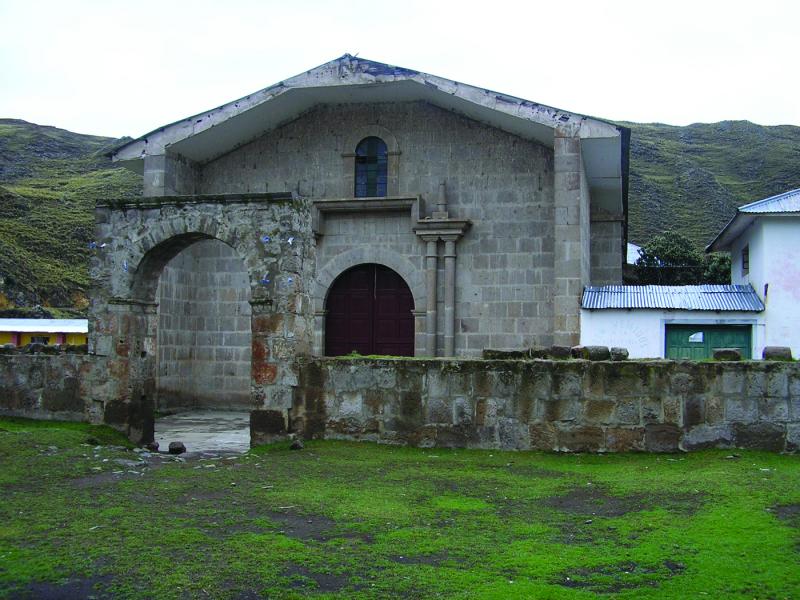
It’s a long way from the Philippines to South America. But for God there’s no such thing as a far place. His call can bring anyone anywhere, anytime. In his mysterious ways, God was preparing me through my 22 years of priestly life to respond willingly to his call to mission ministry. Two year ago, I had made my decision to volunteer for such. I was just waiting for the right time to do it. In a providential stroke, I received an invitation letter from the Society of St. James the Apostle (www.socstjames.com) to join, giving me an opportunity to work as missionary in South America. I felt that the Society would give me chance to be a missionary while retaining my diocesan vocation.
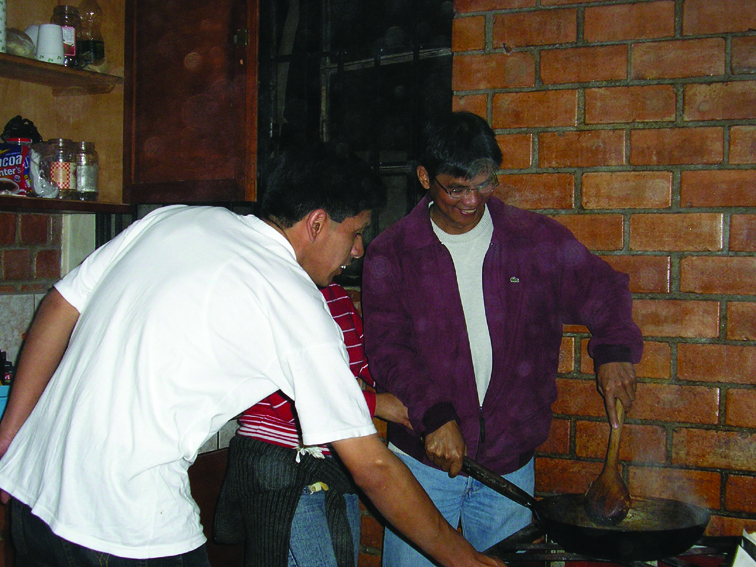
I had my introduction to missionary life and first insights into the culture, history, Church and people of South America during five months of studying Spanish in Instituto de Idiomas Maryknoll(www.maryknoll.org/EDUCA/STUDY/mli.htm), Cochabamba, Bolivia.
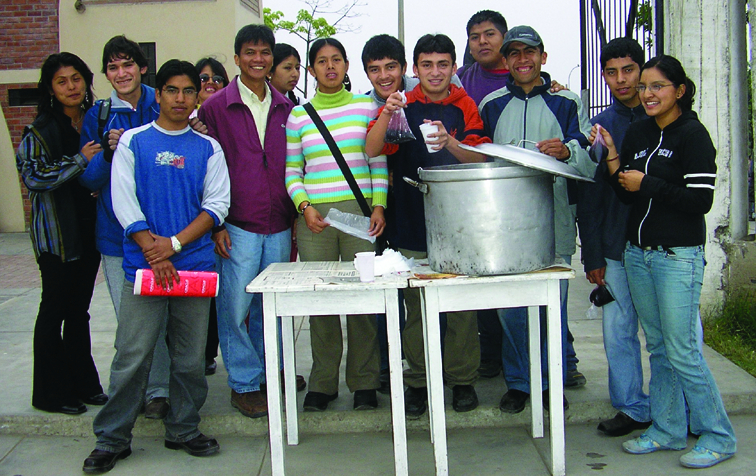
After the course, I flew to Lima, Peru, just before Christmas 2004. I was welcomed by Father Eugene Kirke, the country coordinator of the Society, and the other members working around Lima. Father Eugene, an Irishman, and I discussed where I could work. We agreed that I go to Villa El Salvador to help Father John O'Leary, another Irishman, in San Martin de La Caridad parish.
In my first five months in Villa El Salvador, I went through various stages.
The first stage began in the first few weeks when I was confronted with the reality that adjustment wouldn’t be easy, especially in communication. In my first encounters with the people, I found that I didn’t understand what they were saying and they didn’t understand what I was trying to say. I felt frustrated and often panicky, asking myself, ‘Will I be able to communicate with them? And when?’
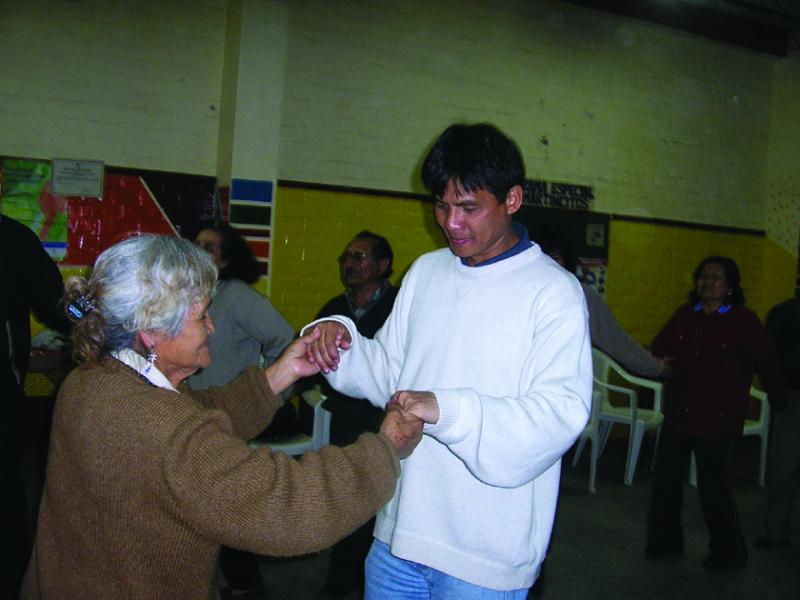
Father Allen with parishioners,
young and old.
Fortunately, the encouragement and assurance of my brother priests made me more patient with myself. They’d always tell me that they too had experienced what I was experiencing. To know and speak another language and, more so, to understand the people and their culture, takes time. The consoling words were, ‘I will learn “little by little,”’ or as we say in Spanish, ‘poco a poco.’
Then I gradually entered into a second stage. I listened and observed more and spoke less. I tried tolisten to what the people were saying. I got to recognize some of the words; at times I could get the general idea of what they were saying. I tried to make sense of everything I was experiencing. I made mental notes of the new and different realities I was encountering. I also recognized situations and customs that were familiar because of my past experiences in the ministry. I felt a certain inadequacy, loss and lack of patience with myself, perhaps because of high expectations. Because of these feelings, I was actively observing but passively participating in various encounters I had. Of course, there were instances where I had to be actively engaged, like celebrating the Eucharist and preaching, hearing confessions, greeting the people after Mass, and visiting the sick. I would spent long hours in preparing and writing my weekday and Sundays homilies. I had to read them at Mass. If not, I’d have a mental block. The people were very understanding and patient with me.
And the third stage was the feeling that ‘enough is enough.’ I couldn’t hide my inadequacy by being silent and preoccupied with what I was saying. So I started to talk and expressed my ideas. And last Pentecost Sunday, I delivered my homily at the youth Mass without my written text. I felt a certain sense of freedom when I was talking to them. I felt happy in spite of the many grammatical mistakes I made. I felt they understood me more because I could express what was in my heart.
This sense of freedom and new way of being with myself and with others opened my eyes to see the different gifts and uniqueness of the communities and persons I was encountering. Knowing their daily struggle to have at least a dignified life made me appreciate who they are. It is a humbling and inspiring experience to witness the generosity and commitment of the many adults and young people in the parish.
My initial experiences helped me to recognize the wisdom of ‘walking with people in their life's journey.’ I think this shapes the life of a ‘beginner missionary’ like me. My experience of being helpless and lost has taught me patience and respect for the process of incorporating myself into new people, situations and culture. It has been humbling, yet at the same time, enriching. Perhaps this initial experience is teaching me to walk more at the side of the people as we are trying to discover together where God is leading his community.
Inspired By St Bernadette
By Father Chris Saenz SSC
Father Saenz, who spent part of his formation in the Philippines and has written for Misyon before, is Vice Director of the Columbans in Chile and Rector of student formation there.
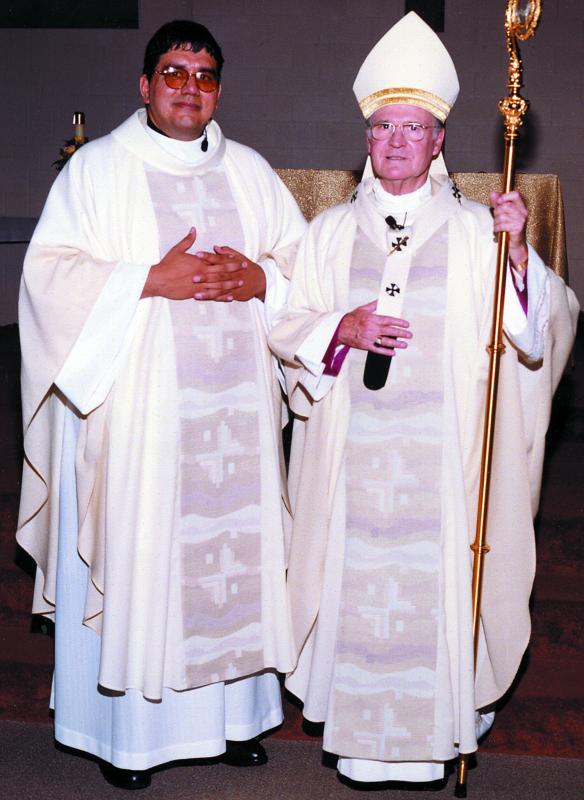
Father Chris on his ordination day
Q. How and when did you experience God calling you to the priesthood?
A. I first received my call to the priesthood when I was about 20 or 21. I was working for UPS and going to college part-time, studying engineering and computers. I had attended the US Merchant Marine Academy, but was expelled because of low grades. I hadn’t attended Mass since I was 14. I was living from one weekend to the next, looking for the next party and taking nothing seriously. I had no idea what I wanted to do with my life.
One day I went to a used book sale at a hotel and came across The Song of Bernadette by Franz Werfel. What interested me was the author, a German Jew escaping the Nazis during World War II and given shelter in Lourdes, France, where he promised if he ever made it out alive, he would write a book about the place.
At this point I had no idea that the book was about St Bernadette and the apparitions at Lourdes in 1858. I figured if a German Jew escaping Nazism found the story worth writing, I should read it. I devoured the book and was intrigued by the history of Lourdes. Later, I rented the old black-and-white movie starring Jennifer Jones and Vincent Price and found it marvelous.
The simplicity, courage and humbleness of St Bernadette made me question my own purpose in life and how I was living. What was I doing for the kingdom of God? How would people remember me? What good was I bringing into this world? From that moment on, I began reading books about other saints and found the desire to be like them.
Soon after, I felt the call to return to the Church. After making my first confession in many years, I became active in various church ministries. From that, my desire to be a priest began.
Q. Who were major influences in your decision to become a missionary priest?
A. When I first received my vocation to the priesthood, I knew instantly that I wanted to be a missionary and not a diocesan priest. I had grown up near the Columban US Region office inNebraska, and was familiar with many of the Columbans and their stories. I grew up listening to their travels and adventures in other lands. I heard about the pains and joys of missionary life. Also, my father was an US Air Force officer and spoke about his many travels to different lands and cultures. Because of these influences I had the desire to see new lands and to experience new cultures and new ways of life.
Q. Why did you choose the Missionary Society of St. Columban?
A. I chose to be a Columban not because I grew up around them but because of their practical spirituality. When I became interested in the priesthood, I looked at other missionary groups and visited them and talked with the vocation directors. However, the Columban spirituality kept calling me back. I liked the Columbans’ practical, down-to-earth spirit. They are always the missionaries who believe in living and working alongside the people they minister to. Most Columbans don’t envision being in high offices, just being in the trenches, the front lines. This I like: a simple, humble approach with the people.
Also, the Columbans’ famous hospitality attracted me. They believe in being good hosts and enjoy entertaining others. A Columban is never known to refuse anybody hospitality. This was always a part of the Columban spirituality.
Q. Was there an episode, event or incident that affected you in a positive way and that reaffirmed your decision during your formation for the priesthood?
A. The most important part of my formation years was my overseas training program. During the years of preparation and formation for missionary life, a young Columban must spend two years doing missionary work. This exposes the young Columban to the work of the Columbans as well as the hardships, struggles and joys of mission life. It helps him to decide if he wants to permanently commit himself to the missionary way of life.
I was sent to Chile and worked in the southern rural part of the country with the indigenous people called the Mapuches. I grew up in the city and had never lived in a small town or isolated, rural areas. The life was difficult for me to adjust to. After my first year in Chile, I became very frustrated with myself. I felt that I didn’t speak the language well, I didn’t understand the people or the culture, and my spiritual life was dry and dark. I found moments where I would just lay in bed and cry at night and not know why I was crying. I seriously considered leaving Chile and the Columbans.
One of my ministries was with a group of teenagers preparing for confirmation. One day after Mass, some of them came over and asked me what was wrong, since I looked depressed. I let it all spill out. I told them that I wasn’t the person to teach them. It would be better if a Chilean taught them, as I felt inadequate and no one understood me. Then one of the teenagers said, ‘That’s why we like you, because you’re like us. Our parents don’t understand us, and the older people don’t understand us. But you understand us because you struggle like us.’
This hit me like a ton of bricks. I never thought I was actually touching people with my inadequacies. Then I realized that mission was not about success or failure, but about the love of God. The youth in my confirmation class loved me in spite of what I could or couldn’t do. And I loved them. I only discovered this while on mission.
Q. Is there anything you want Columban supporters to know?
A. I truly believe we’re living in a great moment of transition in the Catholic Church. It is a scary but exciting moment, because we don’t know where it will lead us. But the Christian faith is not about certainty, but about love. It is about always having faith.
I believe that this great moment is a transition of the Church into the global Church where all cultures and diversity will be respected and share a unified embrace. I am looking forward to all the different countries, cultures and churches coming forward and uniting in love. I am looking forward to participating in and promoting the mission of the Church.
Father Chris Saenz was ordained in 2000 and first went to Chile on mission in 1995. You may write him at Padres de San Columbano, Casilla 311, Correo 22, SANTIAGO, CHILE, or email him atsaenz1967@hotmail.com . The official website for the shrine in Lourdes is http://www.lourdes-france.org/ .
Lessons Learned From Joseph
By Sister Angela Battung RSG
Sister Angela, from Tuguegarao City, is a regular contributor to Misyon. You can learn more about the Religious of the Good Shepherd at www.goodshepherdsisters.org.ph
‘This is my body given for you; do this in remembrance of me’ (Luke 22: 19).
When I read the account of the Last Supper, I almost feel the tension and heaviness in the Upper Room. Jesus is saying, ‘goodbye,’ not a final farewell, because he promises to come back. But his disciples are slow to understand. Jesus knows each one of them well and he loves them. In their own way, the disciples love Him, too. The Last Supper was Jesus’ way of expressing his love for them and for us.
In his encyclical on the Eucharist, Ecclesia de Eucharistia, Pope John Paul II writes, ‘The Eucharist is a priceless treasure; by not only celebrating it but also by praying before it outside of Mass, we are enabled to make contact with the very wellspring of grace.’ Communion with Jesus is a communion with grace, grace that he gives to us through his Church: through people, through friends, a loved one, or a stranger.
Joseph is an old man and most of those who know him love him. My pre-teen students at Sunday school in our parish, The Canadian Martyrs, are very fond of him. One Sunday, the students and I decided to raise funds for Development and Peace to give to the poor children in Africa. We served a ‘poor man’s meal’ of bread and soup and accepted donations.
Joseph came and the students decided the meal was ‘on the house’ for him. He loves to tell stories so he told some about street-life as we washed the dishes and cleaned up. He shared with us his experiences of looking for food in the back-alleys of restaurants, sleeping on doorsteps, corners of houses, under trees or on park benches. ‘Winter is very difficult but God always helps me survive.’ I was told that Joseph was a retired head of a high school, so he had a substantial pension from the government. Why he chose a difficult and dangerous lifestyle no one knew.
One day, I went to a beautiful, luxurious retirement home with wall-to-wall carpeting and lovely paintings on the wall to pick up a donation of clothing for the poor. I met Joseph coming out of the elevator; he was a resident there! He laughed at my confusion and amazement saying, ‘This is my temporary abode, I’m moving soon.’
He would attend daily Mass, receiving Holy Communion, saying ‘Thank you my dear Friend’ instead of ‘Amen.’ He explained that Jesus was a wonderful friend who loved him and gave himself completely to him. ‘Sister, we not only receive Jesus from the priest or minister of Holy Communion. In Communion we give and receive from each other when we show our love for God with a smile; then we make it easier for Jesus to work through us and among us.’
Jesus, broken and given to us, giving us the privilege of sharing God with each other, and living out his command to love and accept each other. Joseph, my theologian and philosopher friend! No wonder he is loved by those who know him.
In winter, he had a beautiful knitted woolen sweater that had ‘menu’ ‘written’ on the front: egg yolk, coffee stains, tiny bits of mashed potato, drippings of gravy, noodles . . .
He taught me many things, such as the meaning of the Lord’s Prayer to explain to me what trust in the Father is: ‘I ask God and God provides. One day, I was cold and hungry; someone gave me half a sandwich and a bottle with a few drops of wine.’
‘Is that all God gave you?’ I asked sarcastically. He looked at me sadly, ‘Sister, you should know the meaning of praying for one’s daily bread; you are always sure of having your three meals everyday. Do you recognize God’s hand in what comes to you so easily everyday?’
One day, he told me about the time he felt so lonely and discouraged that He wanted to die. He sat in the park, frozen and miserable. He had a piece of stale bread and an empty bottle. He planned to eat the bread, break the bottle and then slash his wrist.
Something inside him made him look up . . . a lonely star up there in the dark sky. He felt better – ‘Joseph, a star and God makes three! I am never alone. Joseph, a bird in summer and God makes three, Joseph, a blade of grass in the spring and God makes three. Joseph, a smiling baby and happy children and God makes a community! Joseph, God’s gifts, friends, grace and prayer every moment!’
Thank you Joseph! God, Joseph and Angela makes three! We are always ‘enabled to make contact with the very wellspring of grace’!
‘Lord, you have been a refuge for the needy in distress, a shelter from the storm’ (Isaiah 25:4).
You may email Sister Angela at angeli@ns.sympatico.ca or write her at: Good Shepherd Sisters, 1166 Tower Road, HALIFAX, NS B3H 2YB, CANADA.
News From Norway
by Sister Zenaida Nacpil OP
Dominican Sisters of Our Lady of Remedies Arrive
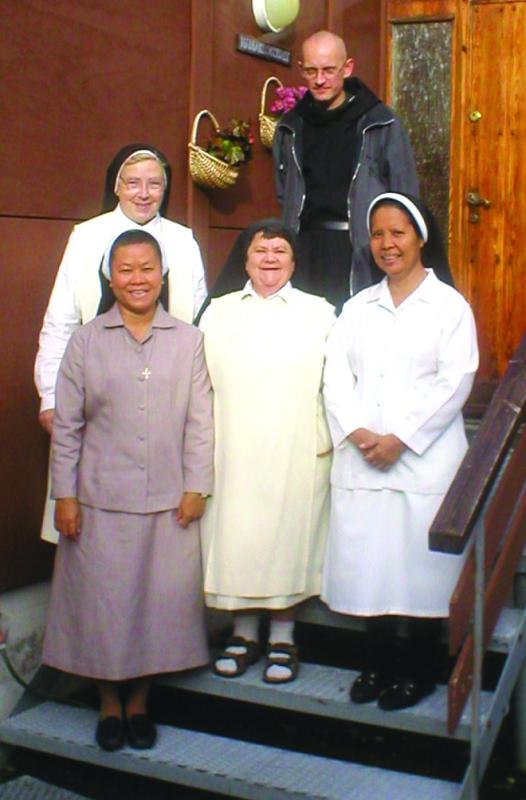
Front: Sr Bibiana, Sr Anna Mary, Sr Zenaida Back: Sr Sunniva, Fr Darius OCSO
Sr Zenaida S. Nacpil OP, ‘Sister Zeny,’ from Floridablanca, Pampanga, and Sr Bibiana T. Colasito OP, ‘Sister Bless,’ from Tolosa, Leyte, arrived in Bodø, Norway, 11 June 2005. Bishop Gerhard Goebel MSF of the Prelature of Tromsø invited the Sisters to come to continue the Dominican presence and ministry at St Eystein parish. Monsignor Torbjørn Olsen, parish priest, followed up the papers of the Sisters through the Norwegian Embassy in the Philippines. Archbishop Paciano B. Aniceto of San Fernando, Pampanga, gave his blessing to the Sisters’ courage and generosity in going overseas for pastoral ministry.
The Bodø Dominican community is a collaborative ministry of the Dominican Sisters of the English Congregation of St Catherine of Siena, Stone, England, and the Dominican Sisters of Our Lady of Remedies, City of San Fernando, Pampanga. How did this come about? Sr Angela Mary Leydon OP, Prioress General of the English Dominicans and Regional Coordinator for Europe, and Sr Zenaida S. Nacpil OP, Regional Coordinator for Asia-Pacific, worked together in recent years on the Dominican Sisters’ International Coordinating Council (DSI). This is an organization of Dominican Sisters from all over the world, with its office at the Generalate of the Dominican Friars at Santa Sabina, Rome. The DSI Coordinating Council has five coordinators, representing North America, Latin America, Europe, Africaand Asia-Pacific. The International Coordinator is Sr Margaret Ormond OP of Mary of the Springs, Ohio,USA. One of the aims of DSI is ‘to explore and foster collaborative initiatives within the Dominican Family.’ The collaborative ministry in Bodø is a concrete realization of this goal.
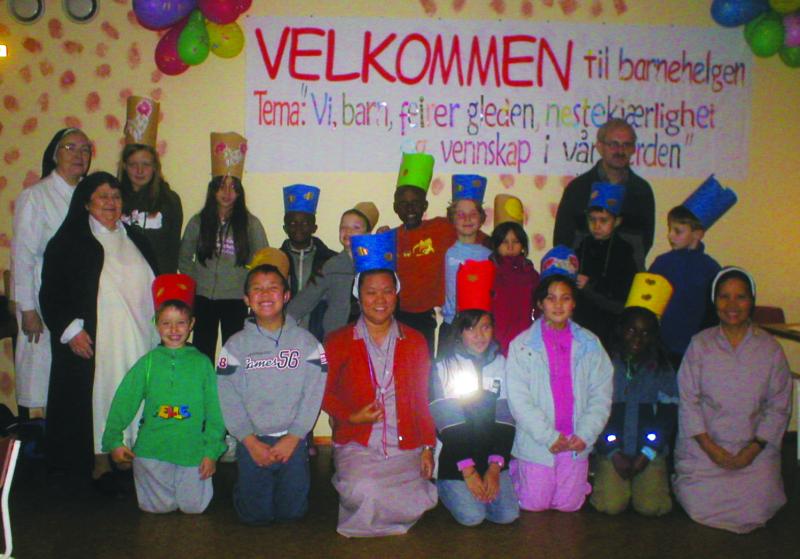
Sr Bibiana, front, center Sr Zenaida, front, right
At the moment, Sister Zeny and Sister Bless are learning the Norwegian language, serving at St Eystein parish and participating in its liturgical and catechetical activities.
Celebration of the Feast of San Lorenzo Ruiz
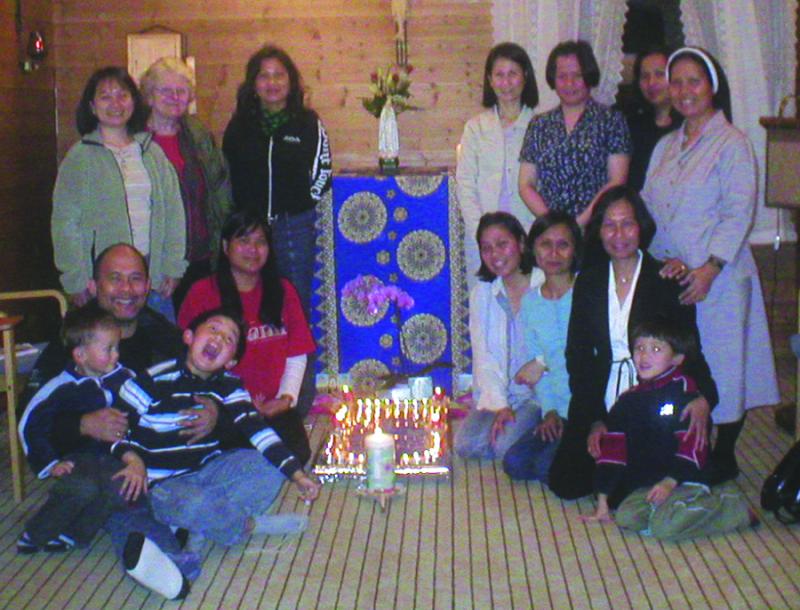
Sr Zenaida, far right, with friends
The Filipino Community in Bodø began the celebration of the Feast of San Lorenzo Ruiz de Manila with the Holy Eucharist celebrated by Msgr Torbjørn Olsen on 24 September at St Eystein parish church. The readings were from the Second Letter of St Paul to the Corinthians 4:5-8 – ‘the power of Christ is made manifest in our tribulations,’ and from St John 15: 1-11 – ‘I am the True Vine.’ The Song to San Lorenzo in English was composed by Sr Anna Mary House OP. Monsignor Olsen expounded on the life of San Lorenzo, father, catechist, missionary, martyr. He is a model for us to imitate. He has fulfilled what St John says, ‘as Christ laid down his life for us, so we ought to lay down our lives for the brethren.’ The blood of martyrs is the proof of their faithfulness to God. San Lorenzo was one of those martyred inNagasaki, Japan, in 1637. He was a Dominican tertiary. He didn’t give up his faith despite the inhuman torture he received. He drank ‘the cup of suffering’, bitter and yet bringing salvation. We recognize that cup on the lips of our Lord Jesus Christ when he said, ‘My Father, if it be possible, let this cup pass from me.’ Truly the martyrs have run the race, have finished the fight, have kept the faith and won the prize – the garland of righteousness.
After the nourishment of God’s Word and the Body and Blood of Christ in the Holy Mass, the parish community gathered in the ‘enighetslokale’ for a festive supper followed by parlor games, an on-the-spot raffle, entertainment with modern dances by the children and a selection of songs in Tagalog and English, including the popular ‘Magic Song.’
It was good to celebrate together as a parish community, a way to foster bonding as a worshipping, caring and celebrating family of St Eystein parish.
You may write to:
Sister enaida Nacpil OP
Marialkosteret, Alkeveien 1b
8003 Bodo, Norway
Silver Jubile of Filipino Sister in Norway
We congratulate Sister Agnes Ofelia Simbillo CB, originally from San Luis, Pampanga, on the occasion of the celebration of her Silver Jubilee in St Olav’s Cathedral, Oslo, Norway, on 6 January. She has been editor-in-chief of Pag-ibig, Tanglaw ng Buhay, the newsletter of Sacred Heart Chaplaincy, since 1996. The chaplaincy serves the Filipino community in the Diocese of Oslo. In 2005 the Catholic population of Norway was 56,308, or only 1.24 percent of the population, 4,557,093. (Source: http://www.catholic-hierarchy.org/). The Catholic Church in Norway has a very informative website, http://www.katolsk.no/ , which has pages in English.
Our Hideaway
TRIBUTE TO A TEACHER
By Cherry Mee T. Degoro
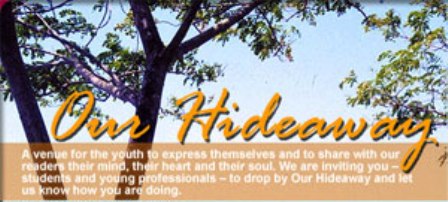
One of the best features of Misyon is the youth page. I wish, one day, through this best feature I could pay tribute to my best teacher.
Since I became aware of my reading and writing skills, and of certain habits and attitudes, there has been a deep and sincere longing to express deep gratitude above all to God and my mother, but also to my teachers, most especially my Grade One teacher, Ma’am Leliosa B. Adolfo.
Even now that I’m done with my schooling, the memories of Ma’am Leling are still very fresh and vivid. I couldn’t forget how she made learning so enjoyable, interesting and without pressure. At that time, learning in the classroom of Ma’am Leling was the source of my happiness, since at that time there wasn’t much happiness in my home. Perhaps, this was one of the reasons why I felt so disappointed when ‘no class’ was declared. I thank Ma’am Leling for giving color to my childhood years. She’s indeed God’s instrument in my life and in that of others.
Now that I have my own classroom, I fervently hope that I can also be a source of happiness to my pupils, especially to those who haven’t happy homes. I believe that by honestly carrying out my task in this profession I would somehow show gratitude to God for allowing me to be one of the hundreds, or even thousands, of professionals that Ma’am Leling has produced successfully in her long years of service in the public school, who are practicing their expertise both here and abroad. To mention a few of my Grade One classmates: some have become licensed engineers, pharmacists, veterinarians, medical technicians and teachers, not to mention those I no longer know about. For sure, these former pupils of Ma’am Leling, and even the nonprofessionals, can testify to the way she made little children love learning. After Ma’am Leling was forced to retire from the public school at the age of 65, she was hired by our parish school, Santa Teresita Academy, at the demand of the parents. Now at the age of 73 she is still actively, enthusiastically making the Grade One pupils love and enjoy learning.
I had the chance to be with her again for a year when I was employed at Santa Teresita Academy after I graduated from college. I observed that despite her age, the vigor, love and enthusiasm she had given me and my classmates when we were in Grade One had, amazingly, not changed. It even became more ‘seasoned’ as she dealt with her present students. When I had the chance to talk with her recently, I asked her what her secret was, not growing old in the profession. She smilingly said that she loved her work and it was her happiness to see her pupils learn and grow.
I really learned from her. I want to follow her footsteps. By her fruits, I can say that she’s one of those people who make the world a better place.
Ma’am Leling is indeed worthy of a special tribute.
Patricio: My Father’s Name
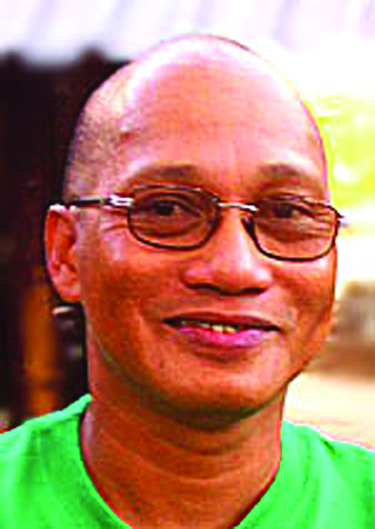
by Father Patricio de los Reyes SVD
Father de los Reyes is Provincial of the Botswana-Zambia-Zimbabwe of the Society of the Divine Word (SVD), www.svdbotswana.com . He has been recovering well from a brutal attack in December at his residence that left him gravely injured.
When I was born on 14 July 1956, everyone in the family thought I had inherited my father’s physical features, and so I inherited his name as Patricio de los Reyes Jr. But I was never meant to be just like my father. After high school graduation, my father suggested I should become a lawyer like him. But I said I wanted to become a missionary priest. So I did. I joined the Society of the Divine Word (SVD) inCebu City and started my training as a Divine Word missionary.
Ten months after my ordination on 23 October 1982, Father Gerardo de los Reyes, my classmate, and I left on 15 August 1983 for the missions through Rome. My month’s experience there gave me a glimpse of how big the tree of Catholic faith has grown; and arriving in Botswana on 21 September 1983 I realized how many of its branches have reached out even to the ‘ends of the earth.’
After three months of tongue-twisting language learning, I joined Father Krystian Traczyk SVD, from Poland, in Serowe. There I started learning, truly learning, to be a missionary. One experience in Serowe that really made an impact on my missionary orientation was our weekly home visits to the sick and the old. Praying is a universal need and gesture of believers and that made me, although imperfectly, one with them.
After three years in Serowe, I was asked if I was ready and willing to be sent to Zambia to start a new mission. Without hesitation, more probably because of my sense of adventure rather than my missionary aspiration, I accepted the offer. So, on 1 April 1986, joined by Father Stanislaw Zysk SVD from Poland, I left Botswana for Zambia. Immediately we plunged ourselves again into tongue-twisting language learning in the western part of the country. Seven months later, joined by another companion from India, Father Kuriakose Kozhikaddan SVD, we started work in Mukuni, a small and compact village just eight kilometers from the world famous natural wonder - Victoria Falls.
I stayed longer in Zambia than in any other country, from 1986 till 1994. I was put in charge of Mukuni. Some years later, I found myself doing more things for the local church, like retreat directing, animating youth groups, coordinating diocesan pastoral planning and so on. Then in 1990 I was given the task of starting our own SVD formation program. So, in August of that year I began with our first group of seven postulants from Zambia and Zimbabwe.
In my initial years as formator, I was still in charge of Mukuni parish and also doing many other things for the Diocese of Livingstone and for the SVD as well, like vocation promotion and coordinating the Overseas Training Program of our seminarians. But frankly, doing so many things at the same time made me realize more and more the things that I could not and ought not do. And plunged into formation work without professional training and preparation also brought me to the realization of how little I knew. The tasks I did from 1990 to 1994 created a vacuum in me like a well that had run dry. Fortunately, I was sent to St Louis, Missouri, USA, for studies. My three years there not only gave me time and space for learning but also for a deeper exploration of myself - my pains, my doubts, mypersona and my faith.
With great hopes and expectations, I came back to Botswana in April 1997 to become a novice master, something that didn’t materialize. But I was in the parish where the novitiate was and helped both in the formation of the novices and in the parish. My ministry in Sebina was short-lived. I was asked after a year to take Palapye, although I had the choice of remaining in Sebina. But I took Palapye because of its challenges. It was a challenge, all right, but I had a wonderful time with the community there. They taught me that I needed to trust them and let them become what they dreamt of being by letting them be and by following at their pace. They re-ignited in me my love for the sick, the old and the poor.
Again, it was planned that I would re-start the novitiate in 2002. So, to prepare for this task, I was sent to the Nemi Renewal Course in Nemi, Rome. This was another event in my life that gave me time and space to dig deeper into myself, especially the shadows which prevented me from growing to maturity as a person. I thanked God for this opportunity. But again, another major turn in my life. Just before I returned from my home leave which I took after Nemi, I was elected Provincial Superior of Botswana-Zambia-Zimbabwe Province for the triennium 2002 - 2005. (Editor’s note: Father de los Reyes was recently appointed to serve a second term). Presently, this is my task and I am full of mixed feelings. One side of me tells me I made a mistake in accepting this task and another side is telling me, ‘go on, take up the challenge.’ However, I’m confident that with my confreres and with God, there is nothing that cannot be overcome.
You may email the author at svd.bots@info.com or write him at: PO Box 209,FRANCISTOWN,BOTSWANA.
Preaching Hope From Prison
By François-Xavier Cardinal Nguyên Van Thuán
The extraordinary story, in his own words, of Vietnamese Cardinal Nguyên Van Thuan, Coadjutor Archbishop of Thành-Phô Hô Chí Minh (formerly Saigon) from 1975 till 1994. Just three months after his appointment he was imprisoned by the communist government. He spent thirteen years in jail, nine of them in solitary confinement. In 1998 he was appointed President of the Pontifical Council for Justice and Peace in the Vatican. He gave the Lenten retreat to Pope John Paul and his staff in 1999 and died inRome on 16 September 2002. Here are some edited extracts from the cardinal’s story.

Notre Dame Cathedral, Ho Chi Minh City
Saved by prayer
In my initial period in prison I spent many months in an extremely narrow space without windows, half suffocated by the heat and humidity. Often I had great difficulty in breathing. They tortured me by leaving me under lights day and night for ten days and then depriving me of all light for long periods. One day in the darkness I noticed a tiny hole through which the light shone. From then on I used to put my nostrils there to breathe more easily.
Whenever there were floods snakes used to invade my cell and sometimes climbed my legs to avoid the water. They used to stay with me until the floods passed. I had no toilet but since I received hardly any food I had little need of one. My daily rations consisted of some rice and vegetables cooked with salt. From five in the morning until 11:30 at night there was a constant din of voices over loudspeakers. To distract myself I did exercises, jumped, danced, sang and prayed. Prayer saved my life. In moments of great suffering, sometimes when I wanted to pray I couldn’t. I was desperately tired, sick and hungry . . . often I was tempted to despair and rebellion. But the Lord always helped me.
Learning again how to pray
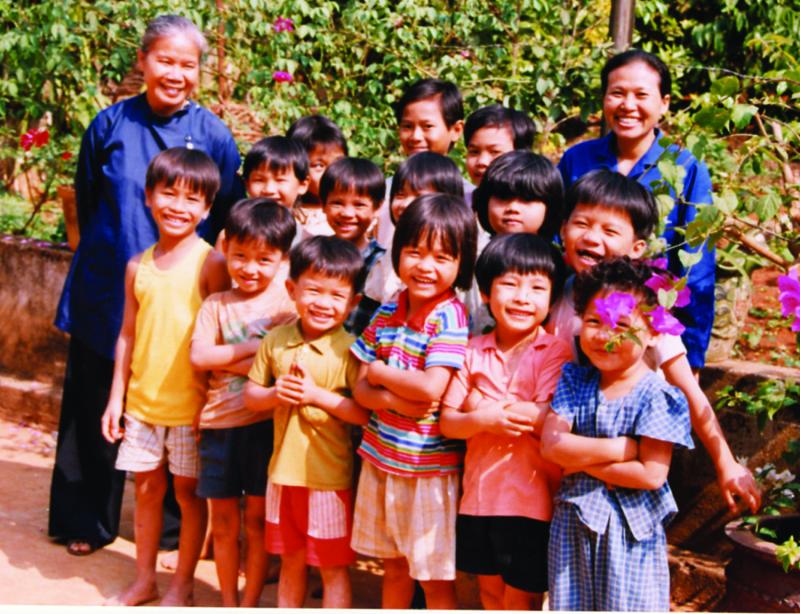
'At that time I was in a closely guarded cell but children were allowed to visit me.'
In my later years in prison five policemen guarded me. Some even studied Latin to censor any documents or telegrams sent to the bishops from Rome. One day a policeman asked me: ‘Can you teach me some song in Latin?’ I replied, ‘I’ll sing some and you can choose.’ He chose the Veni Creator (Come Holy Spirit) and asked me to write out the words. I did so not really expecting that he would learn them. But in a few days he had learned them really well and sang them every morning while he was on guard. I thought to myself: ‘When an archbishop cannot pray, the Lord sends him a policeman to sing the Veni Creator and help him to pray!’
On another occasion a farmer came to the prison and asked permission to visit me. The police permitted it and he spent a few minutes with me. When he was leaving he asked: ‘Please, pray for me,’ and he added: ‘Father, one prayer from you in prison is worth a hundred offered in freedom.’ That day the Holy Spirit sent a farmer to teach me the value of prayer in prison.
Writing about hope
While in prison I wrote several books. All our religious literature had been burned and permission to publish new ones refused. I wondered how, as a pastor, I could encourage the faithful. At that time I was in a closely guarded cell but children were allowed to visit me. One day I said to one of them: ‘Ask your mother to buy me a calendar-block.’ When I received it I wrote my thoughts on the back of a sheet each night and in this way I produced my first book, Pilgrims on the Road of Hope. I wrote the second, The Way of Hope in the Light of the Word of God in the Council in my years in exile, 1,700 kilometers from my diocese. At another time when I was feeling very low and had no desire to write I received a request from the Holy Father asking me to write some spiritual exercises. These later became the workWitnesses to Hope.
I have personally experienced the sorrow of a pastor forbidden to care for his people and forced to abandon his diocese. It caused me great torment to be in prison while the people were abandoned. But I discovered that it had all been God’s work. One night I sensed a voice in my heart saying: ‘François, God holds you in his hands. Always seek his will. God knows what he is doing. He will seek other collaborators who work better than you. Be at peace.’ That night I experienced a deep peace in my heart and I decided to seek God’s will every minute of my life.
Befriended by jailers
At one stage while in prison five young jailers, university students, guarded me. One reason that I survived was because of their friendship.
Those in charge had forbidden them to speak to me. Initially my guards were changed every fifteen days. Prison authorities believed the guards risked being contaminated if left with me for any length of time. Eventually they stopped changing them because apparently they were afraid I would contaminate the whole force. And so the young students became my friends. The love of Christ has great power to change people.
I would chat with them through the door about my life, the various countries I had visited, my family, my childhood and so on. I taught them English, French, and even a little Russian. One day I asked one of them to bring something to trim a piece of wood. He did and I was able to make a cross. Even though all religious symbols were prohibited, I now had a cross in my quarters. I hid it in a bar of soap. Another time I asked for a piece of wire and a pair of pliers. My friendly policeman said, ‘I will bring them but you have to finish in four hours’ – the length of his particular shift. In four hours I had fashioned a chain for my cross. The cross was later enclosed in silver and it is the cross and chain I still wear.
Saying Mass in prison
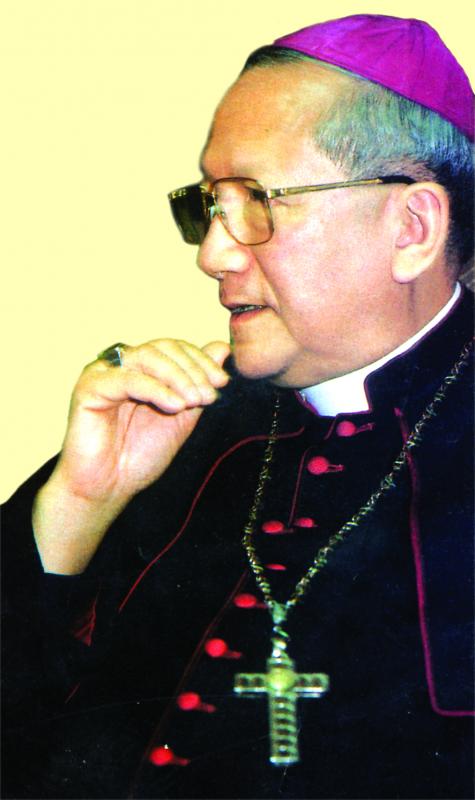
The day I was arrested I had to leave everything behind me. The following day I was allowed to write and ask my friends to bring my clothes, toothpaste and other personal needs. I also asked them to include some wine ‘as medicine.’ My friends understood. They sent me a little bottle of Mass-wine labeled ‘Medicine for Stomach Aches’ and also some hosts hidden in a little burner used to keep the humidity at bay.
Every night I kept a tiny piece of bread for the following day’s Eucharist. And so every day for many years I had the joy of celebrating Mass with three drops of wine and one of water in my palm. This was my altar, my cathedral. For me it was the true medicine of body and soul something to stave off death in order to live for ever in Christ.
Salamat sa Far East, the Columban magazine in Ireland and Britain.
WYD Diary
By Maricel Bedra
‘VENIMUS ADORE EUM!’ ‘We have come to worship Him!’ The World Youth Day (WYD) gathering of young (and old) inCologne, focused on faith that is centered on Jesus and the Eucharist, wasn’t for my group just a day event but twelve days of prayer, worship and friendship.
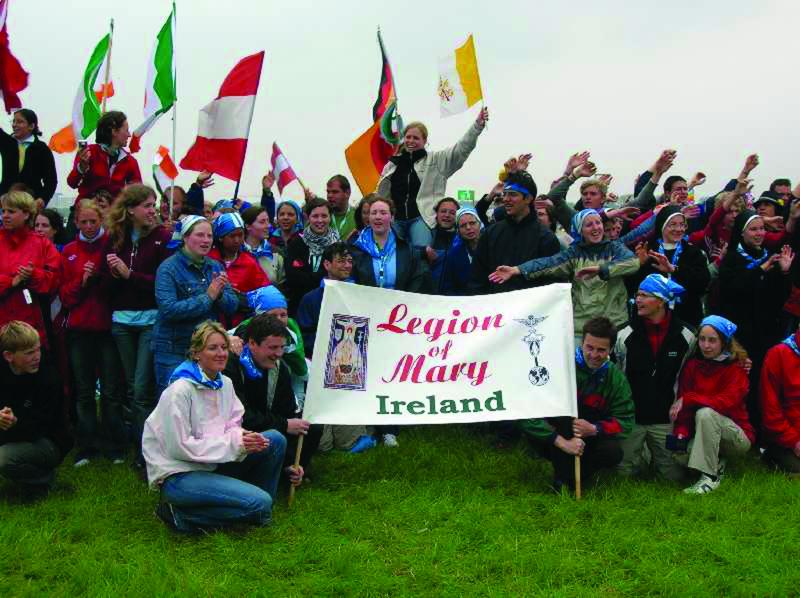
The author, from Victorias City, Negros Occidental, takes care of an elderly couple in Dublin, Ireland, where she is also actively involved with the Legion of Mary.
11 August (Thursday)
With 30 other young, enthusiastic and hopeful members of the Legion of Mary from Ireland and two priests, flew from Dublinat 11am for Zurich, from where a bus brought us to Austria to meet and interact with young Austrian delegates before heading for Cologne. Stayed in Salvatori College dormitory, ten minutes’ walk from Lake Constance. Warm welcome and lovely meal. After we checked in, another ‘meal’ was shared - the Holy Eucharist. Church beautiful and peaceful. The Holy Mass helped me to settle and focus on why I was there.
12 August (Friday)
We started this sunny day in the best way, with morning praise. After a good breakfast, happily served by the three Polish nuns running the dormitory, we ‘chilled out’ at the lake. Still in disbelief that I was in beautiful Austria. Many locals and tourists enjoying the warm waters and sun. Enjoyed my swimming, as I hadn’t been to the beach in Ireland for a long time because of the cold water.
Evening Mass followed by a concert to welcome us. The work and preparation by the young Austrian team that night was amazing. Dancing, singing, and getting-to-know-you activities. Late night!
13 August (Saturday)
Another day of worship and prayer! Through nature – 10 km mountain hike. Packed lunches. Everybody thrilled to see the awesome and serene landscape of the Austrian mountains. Not without slips, glides, falls and dirt - tiring but enjoyable.
14 August (Sunday)
Mass in German, English and Irish with lively singing and participation by all. Beautiful!
Afternoon, workshops and other activities including rosary bead-making, street evangelisation, Irish Céilí and set-dancing and an anti-abortion lecture that I attended. Shocked to hear that more than a thousand babies are aborted every year in Austria. But I admire the dedication and work of MARIA, a pro-life organization that helps pregnant women not to take the abortion option.
15 August (Monday)
We set off at 5am for Germany, with stops to stretch and eat during the 5-hour bus trip to Himmelfahrt (Ascension) parish inDusseldorf where we were being hosted. Atmosphere lively, friendly and accommodating. The young Austrians happy to stay in a school hall. Irish distributed among host families. With five others, I stayed in an apartment owned by a lady, to my surprise, an active member of the local Protestant church! Quite remarkable how quickly a city can change and suddenly lose its indifference.
16 August (Tuesday)
Given our individual ‘Weltjuventag, Köln’ (‘WYD Cologne’) rucksack, meal tickets and nametag, the latter the ‘passport’ to all public transport and different events around the cities. Wore it with pride as an official delegate!
Busy attending different events. At 4pm, 50,000 pilgrims assembled in the LTU arena in Dusseldorf, awash in colorful flags waved by participants from all over the world waiting for the opening Mass at 6pm, which Cardinal Karl Lehman, President of the German Bishops’ Conference, celebrated, with nearly 200 concelebrants. A wonderful concert by international performers entertained us afterwards.
17 August (Wednesday)
A wave of good humour flowing into the city with WYD! Streets, squares, underground terminals, bus stations, markets and museums overcrowded.
On our way to the River Rhine in Cologne we greeted each other with ‘high fives’ ‘hey, amigo’ or a simple ‘hello!’ Nearly a million pilgrims had arrived to visit to Cologne Cathedral where the relics of the Three Wise Men are displayed. A very long procession, so we prayed many decades of the rosary. A rather contemplative pilgrimage was turning into something of a happening. Crowds from Italy waving their huge flags and chanting ‘Benedetto’ with rhythmic clapping in anticipation of the Pope we would finally meet in the next few days. ‘If you can’t beat ‘em, join ‘em!’ So we did!
18 August (Thursday)
After the chaotic transport system yesterday, it was far better to walk than wait your turn to get on a train. Our group decided to do street evangelization in downtown Dusseldorf. We went in pairs and distributed miraculous medals and leaflets. We introduced ourselves as Legionaries of Mary and spoke about the organization and the Catholic faith. Some politely said they weren’t interested. We didn’t insist. As Frank Duff, our founder (http://www.legionofmary.org/fduff.htm), says in the LegionHandbook, ‘Offer the faith to every person. Our Blessed Mother is their mother too. And offer it with a smile!’ We got a good response. The experience was challenging!
19 August (Friday)
We walked to a nearby parish for catechism, like little children on a field trip!!! The worst - I was assigned to be the official ‘headcounter’ of this wild Irish group!
An afternoon of cultural entertainment, delightful food and getting to know each other at an international gathering of Legionaries of Mary in a packed St Himmelfahrt’s. It’s amazing how the organization has spread all over the world from very humble beginnings in Dublin.
20 August (Saturday)
The ant-like trails of a more than a million people walking from various directions and finally coming together at Marienfeld (Mary’s Field) to meet the Pope was fascinating.
I particularly admired the Germans for their organization and logistics of this huge event. They were environment-conscious too. The paper plates and cutlery made of corn grains could be used as compost. Portable toilets, washing areas, drinking-water stations and segregated bins were in every corner.
The atmosphere that night was vibrant. We stayed around the big screen, enjoying the prayers and music. A beautiful scene when the candles were lit in the pitch dark at Marienfeld.
21 August (Sunday)
Thank God, it didn’t rain! But all the sleeping bags got damp from the dew. Woke up at 6 on a bitterly cold morning, went to the coffee station and tried to keep myself warm. Very few people were up. The cold night surely had ‘frozen’ some. Slowly, morning was breaking. Music playing and people starting to wake. I tried to get closer to the pathway where I thought the ‘popemobile’ would pass. Unfortunately, the closest I could get was near the big screen. The Mass was long but we didn’t feel it. It was beautiful. I was very happy! The message of the Pope to go home and bring the Good News to everybody was challenging. Once you’ve found Christ, you can’t keep the joy to yourself, just like the Wise Men after they saw baby Jesus, who kept the faith and shared it with others!
After Mass, we let the crowd ease up a bit and started our journey back with a long walk along the fields to the train station. Most local families had prepared hot tea and water outside their homes for the pilgrims. What a remarkable event!
22 August (Monday)
An evening flight back to Dublin, so a free morning. A friend and I visited the Carmelite monastery in Cologne. Our hostess offered to bring us. What’s special about the monastery is Edith Stein, St Benedicta of the Cross, (http://www.ewtn.com/faith/edith_stein.htm) a Jewish-German woman who was once atheist but became a Catholic saint and martyr. The place was very peaceful. A young nun showed us some relics of Edith and told us the saint’s wonderful story. A good way to end the visit to Germany.
On the plane, I was recalling every detail of my experience. I said to myself, ‘Definitely, I have come to worship Him! I’m going home tired but refreshed and happy’ . . . Roll on WYD, Sydney 2008!
You may contact Maricel at mlbtulla@yahoo.com
WYD – Tripoli Style
By Veronica C. Ugates
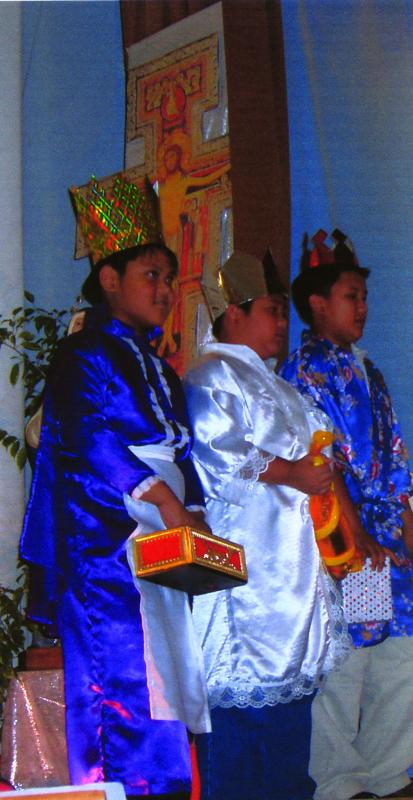
The 'Kabayan Kids' presented the 'Visit of the Mag' with great gusto.
The author is Senior Nurse at Veba Oil Operations in Tripoli. She was one of twelve Bagong BayaniAwardees in 2005. These are given each year by the Philippine Overseas Employment Administration (POEA) to outstanding Overseas Filipino Workers (OFWs). As she couldn’t be present at at Malacañang on 2 December, Father Arturo Cunca OFM accepted the award from President Arroyo on her behalf.
Since most of us were unable to go to Cologne due to financial constraints, Bishop Giovanni Martinelli OFM of Tripoli, Libya, decided that St Francis Parish, Dahra, should have its own Youth Day Celebration in the spirit that inspired WYD in Cologne, Germany. The feast of the Holy Rosary, 7 October, was chosen as it fell on a Friday, the day of worship here in Tripoli.
Fr Alberto Sekito, a visiting Franciscan from the Philippines, organized the affair with the assistance of some parishioners. He called a meeting of the leaders of the different communities, including Dr Walid Abosh of the Arabic community, Mrs Salima Stanley of the Pakistani community, Aisha of the Indian community, and Samuel of the English-speaking African community. Tess Orodio of the Little Souls took care of the order for the Eucharistic celebrations, Raymond Gappi of the printing of the logo, Arman Ugates of the sound system, while everybody else was asked to bring food to share with others.
The week preceding Youth Day was spent in preparations that included catechesis, information on the history of the WYD, the significance of the logo, and the message of the Pope to the different communities in their own languages. The feast of St Francis on 4 October fell in the middle of this so that the Youth Day Celebration was as much a Franciscan activity as that of the youth.
October 7 dawned bright and clear and the excited participants whose ages ranged from the very young to the young-at-heart, arrived early especially the Philippine Community School youth with their energetic directress, Ms Aleth Ramirez. They started the ball rolling by singing ‘Welcome to the Family’ with beautiful dance interpretation. Fr Alberto introduced the different participating communities, followed by the enthronement of the Mission Cross, after which Fr Allan Arcebuche OFM, another Filipino, read the Gospel. When prayers were said in different languages I thought this must be how it was when the Holy Spirit descended on the Apostles and they spoke in different tongues.
The Indian community, composed of nurses from Tripoli Medical Center, presented a dance of welcome and praise to the Lord followed by the pastoral message of Bishop Martinelli. The visiting Minister General of the Franciscans, Fr Giacomo Bini OFM, was the main celebrant at the Mass that followed, with the bishop and priests from different countries concelebrating.
The agape at noon was a great show of culinary expertise, the most exotic food prepared by the Korean community. The less adventurous, however, opted for the mundane sandwiches prepared by the Couples for Christ and El Shaddai groups. After lunch everyone was called to the afternoon’s activities, which started with a presentation by Filipino Fr Celso Larracas OFM, of the world youth situation. Then followed the cultural presentation of the different nationalities.
Watching from the wings of the stage while representatives of the different communities presented their country’s flag, I realized that truly in Libya we were a microcosm of the international gathering inCologne.
This feeling was heightened as the Koreans sang a traditional song, which their leader explained, was dedicated to the old, the youth and the children. A song by the Pakistanis was followed by a lively one from the Sudanese youth, dressed in very colorful costumes, both highly appreciated.
The presentation in mime of the ‘Wedding in Cana’ by the Arabic youth was easily understood and earned warm applause. The Gargaresh community children interpreted ‘The Light of the World,’ the theme song of WYD 2002 in Toronto, Canada, in their own unique way. The Central Passoti ‘Kabayan Kids’ presented the ‘Visit of the Magi’ with great gusto. Though it was a bit chaotic, everybody applauded them for their effort and enthusiasm.
In closing, Fr Daniel Faruggia, Vicar General, bestowed a final blessing. Then the Philippine Community School youth rendered the song, ‘Come and See,’ with such a heartwarming interpretation that I, privileged as master of ceremonies to watch at close quarters, felt an inexpressible and overwhelming feeling similar to what Pope John Paul II must have felt during the first WYD gathering at the Vatican in 1984 when he asked, ‘Who said that the youth cannot be counted on?’ I’ll say further that if we have the youth then we need not fear for the future, for the Church will go from strength to strength through tribulations in the years to come. I believe it worth mentioning that some Muslim classmates of the group joined in the singing.
As a postscript, may I add that the Arabic youth have followed through and now have a weekly youth meeting. Hopefully the other communities will follow suit.
You may email the author at vcugates@yahoo.com
Why WYD Was Special For Me
By Angelica Escarsa
It was a blessing to be at this year's WYD, my third, after Manila in 1995 and Rome in 2000.
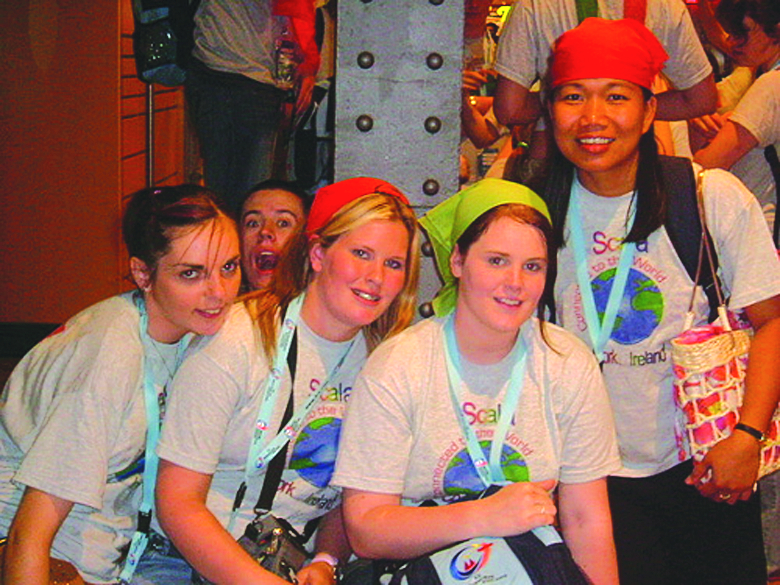
Angie (rightmost) with friends
One of the highlights of this year must be the vigil on Saturday night, 20 August, in Marianfeld, where all the delegates from different parts of the world gathered together for a night of prayer and music. There was something about the vigil that amazed me and really touched me. I was so overwhelmed by the fact that on that very night, despite the cold and the inconvenience of staying outdoor and unsheltered, so many young people came together for a common purpose and goal and that was to celebrate our Christian faith with our Pope through singing and praying. This was a great opportunity for every young person to be open and enthusiastic, a moment where there were no inhibitions but only inspiration, in expressing our Catholic faith in many ways.
One thing I did that very night, which I’d done before in Manila and in Rome, was to take a walk around 3 in the morning when everyone was lying on the ground sleeping. I felt so connected to each one of them. And as I walked along I prayed for them. I might not have met all of those people but through prayer I made myself connected and united with them. And that was the beauty of WYD for me, the chance to be with other young people in prayer and be able to pray for them. I prayed that we as Christians will find more strength and confidence in our faith through the inspiration coming from celebrating the Eucharist.
World Youth Day
By Samuel Goyvaerts
Samuel Goyvaerts is a Belgian university student. He wrote in the September-October issue about playing the part of Magellan in a Filipino celebration in his town.
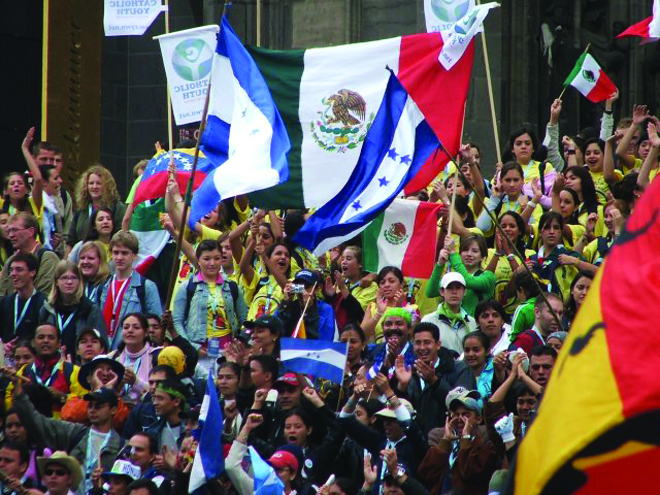
I won’t forget quickly the experience of going to Cologne last August with 1,300 other young people from Flanders, the Dutch(Flemish)-speaking part of Belgium, for World Youth Day. One, for example, welcomed 100 young people from the Canadian diocese that had hosted its young participants in WYD 2002 in Toronto.
In my diocese we worked on the theme of the Three Kings, reflecting the theme of WYD XX We have come to worship him (Mt 2:2), based on the tradition that the relics of the Magi are in Cologne Cathedral. We walked for three days, ‘following the star that would lead us to the newborn Jesus,’ searching, sharing, praying and celebrating together. We slept in a different place each night. Our group of about 150 included two from Chile, a young man from India, two pilgrims from Israel, two from Brazil and a young woman and priest from Rwanda. We learned a lot about these countries: how it was to be part of the very small minority of Christians in India, for example, living together with Hindus and others. We discovered how difficult it was to reach everybody in the rough Andes Mountains of Chile and teach catechism to youngsters in very small, isolated villages. The pain caused by genocide and child-soldiers in Rwanda was another reality we came in touch with.
After five days of preparation in the five Flemish dioceses we all gathered with in Scherpenheuvel, the most important Marian pilgrimage site in Flanders. Cardinal Godfried Danneels, Archbishop of Mechelin-Brussel, celebrated Mass with us. Afterwards there was a youth festival but we left early in the morning.
In Cologne I, with some others, stayed with a German host family. They were very hospitable. So were all the German people were. They helped us find our way around Cologne, telling us what bus or tram to take. They hung out welcome banners and would just start talking with us, asking where we were from and if we needed any help. And not only the German people were so friendly - everybody was. I really felt part of one big family of brothers and sisters who treated everybody equally with the same smile and friendliness. It really was like coming home.
The crowds at Mass also impressed me much. Celebrating your faith with hundreds of thousands of youngsters is impressive, especially when you realized that the motivation of all was the same: Christ. All had come to worship Him!
And we did worship: The opening Mass in the stadium, the Stations of the Cross, the celebration of the sacrament of reconciliation, the Vigil with the Pope and the concluding Mass are only the highlights. There was also morning and evening prayer, Taizé (www.taize.fr) prayer meetings, adoration of the Blessed Sacrament, the songs and music we made. You could say that everythingwas worship.
It was a pilgrimage of hope and love, but mostly of faith in the one and only God. All these youngsters came all the way to Cologne to worship Him.
My wish and prayer is that returning home we won’t stop worshiping Him. We have to thank Him every day for the life and the opportunities that He has given us. And even more than that we thank and worship God because He has sent us His only Son Jesus, Yeshua, Savior.
You may write the author at Leuvensestraat 91, VILVOORDE, BELGIUM or email him atsamuel_goyvaerts@hotmail.com
Your Turn
In the September-October 2005 issue we published a letter from a student to Sister Grace Dorothy Lim about her article Strange Encounter. Here below is another letter to Sister Dorothy by a high school student from St Scholastica’s College, Manila.

Dear Sr Grace Dorothy Lim,
I am Bernadette Cortes, a third year high school student in Scholastica’s College Manila. My professor in Christian Living Education as
In the September-October 2005 issue we published a letter from a student to Sister Grace Dorothy Lim about her article Strange Encounter. Here below is another letter to Sister Dorothy by a high school student from St Scholastica’s College, Manila.
Dear Sr Grace Dorothy Lim,
I am Bernadette Cortes, a third year high school student in Scholastica’s College Manila. My professor in Christian Living Education asked us to comment on any article we read in Misyon. The minute after I have read your article I knew I had to write to you. I really am not sure what the main reason was but I guess because of the title of your article. It attracted me in a way that I really wanted to read it, maybe because like you I myself had a strange encounter that changed my life. Although my experience will be nothing compared to yours I still would like to share it to you.
When I was still in first year I was a transferee student so I didn’t know anybody at the time. As time passed by I got to know more of my classmates. Then I met a girl who became my worst enemy. I mean wherever we saw each other I knew that an argument would arise. When I reached my sophomore year I was really shocked that my worst enemy in first year was now my classmate. At first, I really didn’t know much what to do. One day, she suddenly approached me and we had a conversation. Eventually, we became best of friends. As of today, we still are. I think this experience was a plan of God for me and that I was meant to have her for my best friend. Even though, we are no longer on the same class we still are close. I think that we are closer now than when we were before when we were classmates.
From this experience, I learned that the saying “Things are not always what they seems to be” is true. After all I did think that my friend was not a very good person but now that I have come to know her, I realized that she is one of the most beautiful people in the world I have ever met. She is also the reason why I now appreciate and believe more in myself. I am forever grateful that God gave me the opportunity to meet a person like her.
Thank you for giving me the chance to share my experience to you. I am hoping to hear from you soon. Good luck may God always bless and guide you.
Sincerely,
Bernadette Cortes
Scholastica’s College - Manila
ked us to comment on any article we read in Misyon. The minute after I have read your article I knew I had to write to you. I really am not sure what the main reason was but I guess because of the title of your article. It attracted me in a way that I really wanted to read it, maybe because like you I myself had a strange encounter that changed my life. Although my experience will be nothing compared to yours I still would like to share it to you.
When I was still in first year I was a transferee student so I didn’t know anybody at the time. As time passed by I got to know more of my classmates. Then I met a girl who became my worst enemy. I mean wherever we saw each other I knew that an argument would arise. When I reached my sophomore year I was really shocked that my worst enemy in first year was now my classmate. At first, I really didn’t know much what to do. One day, she suddenly approached me and we had a conversation. Eventually, we became best of friends. As of today, we still are. I think this experience was a plan of God for me and that I was meant to have her for my best friend. Even though, we are no longer on the same class we still are close. I think that we are closer now than when we were before when we were classmates.
From this experience, I learned that the saying “Things are not always what they seems to be” is true. After all I did think that my friend was not a very good person but now that I have come to know her, I realized that she is one of the most beautiful people in the world I have ever met. She is also the reason why I now appreciate and believe more in myself. I am forever grateful that God gave me the opportunity to meet a person like her.
Thank you for giving me the chance to share my experience to you. I am hoping to hear from you soon. Good luck may God always bless and guide you.
Sincerely,
Bernadette Cortes
Scholastica’s College - Manila